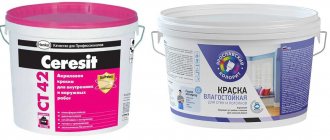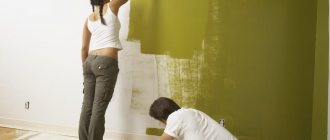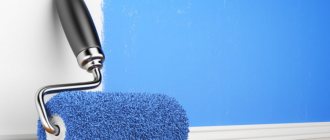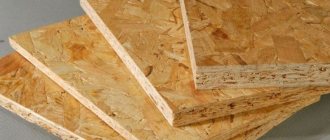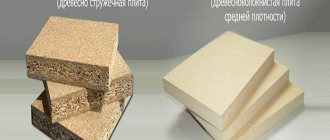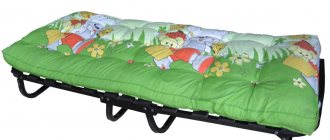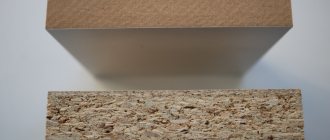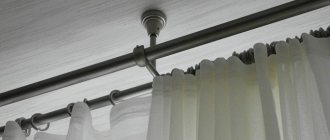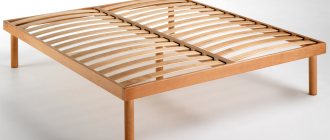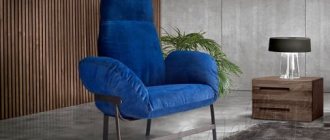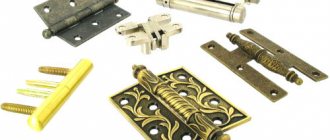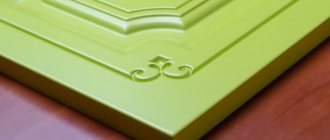Updated: 04/23/2021 12:51:21
Expert: Konstantin Borisovich Polyakov
Every person wants his home to be cozy and beautiful. And the right choice of finishing materials is quite capable of helping to turn your home into a “nest”. And it is especially important to approach the selection responsibly with a limited budget for repairs.
Some of the cheapest paints and varnishes on the market are water-based and water-dispersion paints. At a low price, they are characterized by good coverage, durability and a variety of colors. But what should you choose for arrangement?
In this material we will look at the differences between water-based and water-dispersion paints – and what is better to choose.
Pros and cons of water-based paints
Water-based paint is in demand due to its decent quality.
At the same time, the cost of this paint and varnish product is quite affordable. It consists of polymers and pigments. At the very beginning, it is neutral in color, but then the color notes transform. This paint and varnish material has a number of positive aspects:
- no smell;
- dries instantly;
- non-toxic;
- fire resistant;
- easy to use;
- no need to dilute with chemical compounds;
- low consumption;
- easily washed off from hands and tools after work;
- A large selection of colors allows you to choose an individual one for yourself;
- low prices for this type of material.
If the choice is made in favor of water-based paint, then all that remains is to choose the best one for yourself, after familiarizing yourself with these products in more detail.
Painting tools
Before starting finishing work, prepare the necessary tools, which should always be at hand.
Types of tools:
- The roller is foam rubber or fleecy.
- Paint brush for painting hard-to-reach places.
- Masking tape.
- Spatula for cleaning walls and mesh for sanding.
- Sponge.
- Paint tray.
- A bucket for putty.
- Ladder or trestle.
A set of tools for work Source remitek.ru
Features of acrylic compositions
The main components of this group are acrylic composite and water. During the drying process, not only moisture evaporates, but also polymerization of the components occurs, resulting in the formation of a highly durable coating.
Acrylic is suitable for working with glass, metal, wood, canvas, linen and other materials that have a non-greasy base. Fresh stains of this type of paint can be easily washed off with plain water. However, if the stain has already dried, you have to resort to using a solvent.
Advantages of acrylic paints.
- The products are non-toxic and considered environmentally friendly. They are practically odorless and do not contain harmful substances.
- A wide color palette allows you to choose an option for every taste. In addition, you can prepare the shade you need in a special machine.
- Acrylic paints are resistant to ultraviolet radiation, high humidity and temperature changes. They can be used for finishing both indoors and outdoors. Also, this group of paints and varnishes has a vapor-permeable coating layer, which eliminates the accumulation of moisture in the walls.
- Acrylic coating is durable (it remains in excellent condition twice as long as oil coating).
- The layers dry very quickly. There are brands whose compositions dry in 1 hour.
- The quality and aesthetics of the appearance of the painted surface will satisfy the most demanding customers. After drying, the layers do not crack.
- The paints are frost-resistant (freeze at temperatures below – 40°). However, it should be remembered that thawing should be gradual, even if it takes several days. This process cannot be accelerated with the help of heating devices, hot water, etc. After the paint has thawed, it is necessary to check whether thickened particles have appeared in it or whether it has delaminated. Then you should thoroughly stir the composition and dilute it with water, if necessary.
Marking
The letters and numbers on paint cans are easy to decipher if you have an idea of the meaning of each of them.
Letter marking:
- VE - water emulsion.
- VD - water-dispersion paint.
- CN - composed of butadiene-styrene.
- VA - polyvinyl acetate.
- AK - styrene acrylate.
- BC - polyvinyl.
Number 2 indicates emulsion for interior work, number 1 for external walls.
Having an idea of the composition and properties of enamel, it will not be difficult to choose the one that is suitable for the given work.
Differences from water-based paints
Along with dispersed ones, the use of water-based paints is widespread. Let's look at the difference between water-based paint and water-dispersion paint.
Water-based and water-based paints have the same composition, but what is the difference between them? The difference is in polymers - this can be a general group, for example PVA, or a specific polymer. Some experts argue that there are no differences between these two materials. There is also an opinion that water-based paints are an outdated name, and now they are called differently. However, dispersion paint has some differences from water-based paint.
So, we know what water-based paints are. One of the main parameters of this product is high moisture resistance. Water-emulsion does not have such stability - it is easy to wash off with plain water. Emulsions are produced in a wide range of colors, while dispersed ones are produced only in white in different shades with the possibility of tinting. If you add the desired color, you can get any color as a result.
To add saturation to the dye, titanium dioxide or zinc oxide is added to it. Both water-dispersion paint and water-based paint contain these substances. The difference between them is the price, which depends on the brand. In general, the price difference is not that big, but emulsion materials are a little more expensive.
For painting surfaces in residential premises, water-dispersed or water-based paints are most often used. Despite the fact that the base substance in both cases is water, these compositions are still different.
Below we will discuss the main differences between water-dispersion and water-based paints. To understand what they are, it is necessary to take into account the technical indicators: composition, consumption, viscosity, hiding power, specific gravity, durability, as well as the operating characteristics of the materials.
This type of coatings is widely known to domestic users and has found application in many areas due to the following advantages:
Disadvantages include exposure to low temperatures, especially at the time of application. The operating temperature should be above 5 degrees. In addition, this type of material should not be applied to metal products or surfaces that absorb a lot of moisture. In the first case, the paint will cause corrosion, in the second - premature destruction of the surface.
Water-based paints are intended exclusively for interior or facade work
Specifications
Water-based coatings include ingredients such as latex, thickeners, fillers and optional additives to increase resistance to water, ultraviolet rays, and so on. The viscosity of this material is controlled by water. To determine this indicator, a special tool is used - a viscometer. The optimal viscosity is 40-45 St when using hand tools (rollers, brushes, sponges, etc.). If you plan to apply the material using a spray gun, then this indicator should be no more than 25 Art.
If we take the average data provided by manufacturers, then the consumption of water-based paint is 200 ml per 1 square meter of treated surface. But in reality, this characteristic may be different due to the absorbency of the base, the degree of its preparation, the tool used, and so on.
The average specific gravity of this type of paint does not exceed 1.4 kilograms per liter. The drying time directly depends on the humidity and temperature in the room. Also, different compositions can dry for different times: from 2 hours to a day. It should also be noted that painting work is best carried out at a temperature of about 20 degrees Celsius and a relative air humidity of 65-70%.
Types of water-based compositions
The modern construction market offers the following types of materials:
- Acrylic. As the name implies, the material is based on acrylic resins. These compounds are considered to be of sufficient quality, strong and durable.
- Mineral. Additional ingredients include slaked lime or cement. Paints can hide minor defects in the surface being treated, but they do not last long.
- Silicate. They are a mixture of liquid glass, dye and solvent. They can last up to 20 years without losing their original appearance.
- Silicone. The strongest and most durable materials, but, unfortunately, very expensive. This is what mainly distinguishes the compositions from water-dispersed paint.
Conclusion
Despite the fact that most of the composition of the presented paints is made up of ordinary water, they can differ significantly in cost. In addition, materials differ in their hiding power.
It should also be said that dispersed paints are resistant to water, while emulsion paints are easy to wash off from the surface. The materials also differ in the solvent used. To control the density of dispersed compositions, water is used, and emulsion compositions use white spirit. In addition, the first option is produced exclusively in white, while the second can be multi-colored or tinted.
Disadvantages of acrylic solutions
The disadvantages of products do not seem so significant compared to the advantages, but they can play an important role in the choice. Among the negative points stand out:
- Expensive. The price of this composition exceeds the cost of other varieties, which is compensated by the hiding power of the paint. This indicator reduces the number of layers required and mixture consumption.
- Not too high vapor permeability. But this is not always a serious disadvantage. For example, concrete surfaces have low vapor permeability, but they are the ones most often found in ceiling structures that require painting.
When choosing products, all available features are taken into account.
Basic properties
The water-dispersed base is the main advantage of the finishing material. The optimized composition of the paint and its unique components allow you to process any textured interior item and paint the surface of stone, wood, brick, concrete, as well as plastered walls. Due to the high-quality dispersion of pigment components, the most significant defects are masked. In addition, the high wear resistance of VD AK paint is higher than that of other enamels.
Important! Some water-based paints require the use of a primer. Such primary treatment is also required when repainting interior items or facades.
Acrylic paint
It is an improved version of the water-based one. The composition of the paint and varnish material includes the following components: distilled water, polymer acrylic emulsion, dye. Polyacrylics with copolymers contained in the paint form a special protective film on the surface being painted. The paint and varnish composition is superior to other types in quality and durability. After painting, the base acquires an expressive and rich color that does not fade under the influence of ultraviolet rays and is not washed off due to high humidity. The water base ensures no odor after drying. To obtain a bright shade, the paint is applied in several layers. Acrylic paints are suitable for artistic painting. They are used in the design of design elements and the creation of original interiors. The composition can be diluted with water. To obtain a paste, the paint is diluted with a special compound. Paint and varnish material is often used for painting artistic paintings.
Advantages
Acrylic paint has many advantages, thanks to which it is widely used for painting various surfaces:
- the composition hardens in half an hour, and dries completely after a few days and much faster if the air temperature is high;
- the coating gives the surface a beautiful appearance, resistant to fading and washing off, which guarantees a long service life;
- the presence of a protective film, which provides not only durability, but also prevents rolling and cracking;
- the versatility of the paint allows the use of compositions for coloring, painting, and creating artistic canvases;
- the absence of toxic substances makes the material absolutely environmentally friendly;
- a variety of colors allows you to choose a color or shade for absolutely any interior;
- the absence of combustible and flammable components makes the paint fireproof.
The simplicity and ease of application of acrylic paints allows even an inexperienced person to paint. There is no need to involve a specialist in such work.
How to choose
When choosing, it is important to consider the differences described above. They start by assessing the type of room in which the work is planned to be carried out. Not just any paint is suitable for cold rooms. You should also take into account the specific conditions in the room, including humidity levels, etc.
Among other things, when choosing a composition, you should focus on the following nuances:
- Price. If you do not plan to spend a large amount on facing material, then the water-dispersion type. They are cheaper;
- Manufacturer. This affects the quality of the material. It is recommended to choose brands that have proven themselves on the positive side. This will allow you to purchase a high-quality composition that is reliable and durable;
- Room design. Depending on the interior, a suitable palette will be selected. Not all types of paints have a rich range of shades. Therefore, the desired composition may not be in the desired tone.
Depending on the interior, a suitable palette will be selected.
The water base of both types is their common feature. But there are enough differences. They affect further operation. Therefore, it is necessary to familiarize yourself with the nuances of each composition in advance in order to choose the most suitable one.
What to look for when choosing
When choosing paint for the ceiling, it is recommended to adhere to the following criteria:
- When choosing the color and texture of the material for painting the ceiling, you need to take the interior style of the room, its purpose and the dominant color shades as a guide. Ceiling paint can be matte, semi-gloss or glossy. The latter option helps to achieve a visual expansion of space. Matte white paint imparts a discreet nobility and balance to the home.
- Preparing the base for painting is labor-intensive, because... the finished surface must be perfectly flat. It will require laying several layers of putty and sanding. It is impossible to disguise even small defects with painting: as a rule, they become even more noticeable. First of all, this applies to glossy compositions that highlight all the depressions or bulges well. Matte paint is more practical in this regard, as it allows you to hide minor flaws. The best option in such situations are semi-gloss materials.
- Water-based paint contains water, so it does not tolerate freezing very well. Based on this, it is not recommended to purchase material in winter from unheated markets and warehouses. In essence, these are paints for ceilings in residential premises.
- It may seem that both expensive and cheap paints have similar characteristics. Expensive brands have superiority in practicality: this means material consumption per m2 of base. This is especially noticeable when painting large spaces.
- It is worth understanding that the popularity of a brand does not always indicate its quality. Sometimes lesser-known materials have better performance characteristics. The point is in fakes, which often use popular logos. In addition, new manufacturers are trying to win their place in the sun due to the high quality of their products and their low cost.
- In most cases, paint buckets contain instructions that the material is intended for finishing ceilings. If there are no indications of narrow specialization, then universal paints for interior work are a suitable option. As a rule, these compositions adhere very well to the base, which allows you to get rid of drops on the surface.
- Sometimes during painting, instead of the declared snow-white surface, a slight tint appears on the ceiling. Good manufacturers specifically introduce a special pigment into the composition, which helps to quickly notice unpainted areas. As a rule, after drying the surface becomes completely uniform and white.
- Using glossy paint, a mirror effect is created on the ceiling. Perfectly smooth surfaces painted in this way look especially beautiful. Glossy compositions are recommended for use in small rooms to achieve a visual expansion of space. After drying, such a ceiling can be wiped with a damp cloth.
- Due to the fact that matte paint absorbs light, it can be used to mask small defects in the base. The layer turns out to be dense, which in some cases makes it possible to save on the number of approaches. After drying, matte paint becomes covered with small pores, making it difficult to clean.
Preparing walls for painting
Worn surfaces with stains, cracks, chips and potholes are subject to repair. You can't paint them, it's a waste of material and time. Before starting painting work, the walls should be prepared.
- Cleaning the walls.
Oil paint, old plaster and simply cracked areas are removed using a spatula. Oil paint is preheated with a construction hairdryer. The lime is soaked and washed off with a brush or hard sponge.
If the surface is smooth, you just need to remove the old coating - use a grinding machine.
- Sealing irregularities.
The cracks and cracks are carefully cleaned and slightly widened so that there are no loose edges left. Then putty or seal with silicone and leave until completely dry.
Dry areas are sanded smooth and dust is swept away.
- Decoration of corners.
Corners left neglected will ruin the beauty of the renovated room. They are decorated with a silicone corner and puttied. Then they clean and polish.
- Preparation of reinforced walls.
Surfaces with metal reinforcement are puttied to hide the mesh and make the wall smooth. To avoid rust, the metal part is treated or paint with anti-corrosion properties is selected.
To see the nuances of painting walls, watch this video:
- Primer.
After sanding, the smooth surface is treated with a primer and left until completely dry. Drops and streaks on the floor are washed off with water within the next hour, then the primer hardens and it will be much more difficult to clean it off.
- Protective measures.
All parts in contact with the edge of the surfaces to be painted are sealed with masking tape. These are baseboards, window sills, platbands, etc. The transition points from one color to another are also separated with tape. It must be removed immediately after applying the paint, without allowing it to dry completely.
It is better to cover good clean floors with polyethylene or paper in advance. If you fail to wash off the paint or primer immediately, stubborn stains that are difficult to remove may remain, especially on varnished floors.
Water based paints
Materials based on distilled water are intended for both internal and external use. They contain additional binding components that determine the layer’s resistance to external (mechanical, temperature or atmospheric) influences. For application, use brushes, rollers (with coats made of any material), as well as sprayers. The painting method is chosen depending on the area and orientation of the surfaces in space.
The advantage of water-based paints is their environmental safety.
Emulsion dyes
Emulsion materials are a suspension of pigment and additional components in water; after the moisture evaporates, they form a durable protective layer (resistant to precipitation and washing). Use warm water to remove fresh paint from tools or clothing. The compositions are characterized by increased environmental friendliness (when applied and dried, no substances harmful to humans are released into the air). The coating has microscopic pores that allow moisture to be removed from the base.
Acrylic paints
The materials are based on acrylic resins and have increased elasticity. The coating allows you to cover cracks up to 0.5 mm wide, does not collapse and does not lose color when exposed to ultraviolet radiation. Acrylic enamels protect the base from the penetration of water from the outside (for example, they are used for structures with reinforcing mesh or rods). Paints and varnishes have high adhesion (when applied to a dry surface) and are resistant to external mechanical influences.
Textured plasters
The group includes textured plasters containing admixtures of granite or other minerals. After the moisture evaporates, a decorative layer with a rough surface remains on the surfaces; the pigments introduced into the composition make it possible to imitate natural finishing materials. Plaster allows you to seal uneven areas and cracks in walls or ceilings.
Polyvinyl acetate
Emulsion-type enamels containing polyvinyl acetate (PVA), pigments and additives to stabilize and impart elasticity to the coating. The industry offers ready-to-use materials and paints made from 2 components (plasticizer and pigment), which must be mixed before application. It takes 2-3 hours for the moisture to evaporate; a semi-matte, uniform film is formed on the painted surfaces, resistant to base deformation and condensation.
Latex dyes
The materials include a suspension of synthetic latex (on an acrylic, urethane, polyvinyl acetate, siloxane or styrene-butadiene base), which forms an elastic film together with pigments. The coating follows the contours of the surfaces and withstands external loads. The layer is permeable to air, is not destroyed by cold and hot water, and does not lose pigmentation under the influence of ultraviolet radiation or chemical reagents (for example, detergents).
Latex paint is characterized by increased wear resistance.
Silicone dyes
The binder is silicate resins; the resulting coating is not washed away by water, but allows air to pass through. The layer is highly elastic; cracks up to 2 mm wide can be painted over without filling with putty. The paints are designed for application to plaster 2 days after finishing; the material has antibacterial properties and can be cleaned with both water and special chemicals.
Mineral compositions
Materials based on crushed minerals are intended for finishing facades made of brick, concrete, or used during restoration or repair work. Paints are often dry (in powder form), which are diluted to the required consistency with water. After hardening, the layer allows evaporation to pass through, allowing excess moisture to be removed, extending the life of building facades. To change the characteristics (for example, adhesion to the base or plasticity), synthetic resins are introduced into the composition.
Mineral compositions are divided into categories on a basic basis:
- lime (based on slaked lime) with inorganic dyes of light shades;
- cement (with the addition of Portland cement), contain slaked lime and calcium chloride;
- silicate, consisting of alkali-resistant pigments and filler;
- oil, consisting of a mixture of pigments and drying oil with the addition of a drier and additives that reduce the likelihood of sediment formation.
Water-dispersed
An aqueous dispersion that dissolves acrylic, polyvinyl acetate and latex components. You can find out what water-dispersion paint is by determining its characteristics. The components dissolved in PVA form a mixture that is inexpensive and wear-resistant. It is used for painting floor coverings, but quickly gets dirty and allows moisture to pass through.
Based on latex, it is stronger than water-based, more stable, has dirt- and water-repellent properties, and the acrylic solution of components is used for exterior decoration of buildings and is well resistant to atmospheric phenomena. The protective surface perfectly withstands repeated cleaning, washing, and treatment with products.
Paint consumption
The consumption of water-based paint largely depends on the diameter of the polymer particles in it. If they:
- Small ones. The composition is easy to apply, but does not spread well. Traces remain. This property of paint is called thixotropy - rapid liquefaction under mechanical action (for example, with a brush) and equally rapid thickening at rest.
- Large ones. Paint with these spreads excessively. What remains are not seals, but smudges.
In the first case, accordingly, the paint consumption is greater. In the second case, the composition is spent to a minimum. But, you have to solve problems in the form of clots and leaks, or put up with them. Therefore, it is advisable to choose the golden mean - a water-based emulsion with polymer particles of medium diameter.
Applying paint to a wall with a roller
The size of filler particles in paint has a lesser effect on its rheological (deformation) properties. The viscosity of the paint is controlled by water-soluble thickeners. Their proportionality can also affect the flow rate along with the diameter of the polymer particles.
Affects paint consumption and composition:
— The highest indicator is for latex. The first layer requires 0.6 kilos per square meter. The second layer takes 0.4 kilograms.
— If the paint is polyvinyl acetate, the square requires 0.55 kilos for the initial application and 0.35 for the secondary application.
— Silicate water-based emulsions are average. The first layer requires 0.4 kilos. The second layer takes 50 grams less.
— Consumption of silicone compounds is 0.3 kilos for the first layer and 0.15 for each square of the second layer.
— The most economical is acrylic paint. There the ratio is 0.25 to 0.15 kilograms per square meter.
The paint consumption is partially affected by the base on which it is applied. If the material is porous or uneven, more water-based emulsion will be lost. The paint is absorbed into the pores of the base, fills the cracks in it, that is, at the same time it acts as a primer. Therefore, it is also recommended to use primer in order to reduce emulsion consumption.
It is due to partial absorption into the base that the first layer of paint always takes more than the second. The number of layers required for high-quality painting depends on the covering power of the water-based emulsion. The term refers to the degree to which the paint pigment covers the color of the substrate being coated. Some water-based emulsions need to be applied in 1 layer, while others need 3-4.
The following factors also affect paint consumption:
- Tool used. With a brush, for example, the consumption is less than with a roller. Rollers with long pile absorb especially much.
- Temperature during work. At low temperatures, the water in the paint sets, and at high temperatures, it evaporates too quickly. Hence the higher consumption. The ideal temperature is about 20-25 degrees.
- Humidity of surfaces and air during painting. In dry rooms, water evaporates from paint faster. Accordingly, the emulsion consumption increases.
- Application technology. Manual application, for example, requires more water-based emulsion than when spraying it from a spray gun.
An abundance of factors makes it difficult to accurately calculate paint consumption without proper skill. Therefore, it is recommended to take a little more than what is obtained according to the formula.
Painting technology
Pour a certain amount of VE into the tray. First, use a brush to treat all hard-to-reach places. Then, using a roller, the main application to the surface begins. The roller is dipped into the tray and lightly pressed onto the corrugated surface.
In a room with a window, the direction of the roller should be parallel to the window opening. The second layer is placed perpendicularly, so that no traces of the roller will be visible.
You can see how to paint walls during renovation work in this video:
Layer after layer is overlapped by 5-10 cm, so there will be no gaps and the border of the previous layer will not be visible.
Application is carried out as quickly as possible, so that later drying occurs more evenly and the VE does not have time to thicken.
The ceiling and high walls are painted with a roller mounted on a long rod.
For large volumes use a spray gun. The speed of the mechanism is up to 150 kW. m/hour.
Allow the surfaces to dry for an hour and repeat the application of VE perpendicular to the previous layer.
They check for any flaws and correct them immediately, without waiting for complete drying.
During painting, horizontal and vertical layers alternate Source guruotdelki.ru
Popular products
There are several types of VDAK paints, each of which has its own unique properties and purpose. General description of the most popular products:
- Paint VD AK-1180. Used as a base for initial and secondary coatings. Weather-resistant, moisture-resistant, covers a wide color spectrum. VD AK-1180 paint is popular in the construction of large industrial facilities.
- Paint VD AK-111. Thanks to its unique composition with a latex base, the paint becomes more resistant to mechanical stress and natural factors.
- Paint VD AK-101. The material is suitable for painting surfaces of any type. This paint dries quickly and is completely environmentally friendly, which allows it to be used for interior work.
The most popular paint for exterior work is VGT VD AK-1180 enamel. The material is intended for painting concrete, wooden and plastered walls; it has high water and weather resistance. VGT 1180 facade paint is excellent value for money.
Water-dispersion paints VD AK of other types are used less often or have a narrow profile with limited application properties, for example, painting floors, painting wooden structures, etc. Below we will consider in more detail the technical characteristics of the different options.
On video: features of water-based paints.
